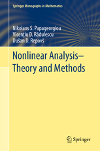- About MAA
- Membership
- MAA Publications
- Periodicals
- Blogs
- MAA Book Series
- MAA Press (an imprint of the AMS)
- MAA Notes
- MAA Reviews
- Mathematical Communication
- Information for Libraries
- Author Resources
- Advertise with MAA
- Meetings
- Competitions
- Programs
- Communities
- MAA Sections
- SIGMAA
- MAA Connect
- Students
- MAA Awards
- Awards Booklets
- Writing Awards
- Teaching Awards
- Service Awards
- Research Awards
- Lecture Awards
- Putnam Competition Individual and Team Winners
- D. E. Shaw Group AMC 8 Awards & Certificates
- Maryam Mirzakhani AMC 10 A Awards & Certificates
- Two Sigma AMC 10 B Awards & Certificates
- Jane Street AMC 12 A Awards & Certificates
- Akamai AMC 12 B Awards & Certificates
- High School Teachers
- News
You are here
Nonlinear Analysis - Theory and Methods

Publisher:
Springer
Publication Date:
2019
Number of Pages:
577
Format:
Hardcover
Series:
Springer Monographs in Mathematics
Price:
119.99
ISBN:
978-3-030-03429-0
Category:
Monograph
[Reviewed by , on ]
Jeff Ibbotson
07/28/2019
This book is a guide to the several important tools which are used to study nonlinear boundary value problems. The entirety of this volume (volume 1 of a two-volume set) is devoted to developing these tools in abstract settings. The actual applications occur in volume 2.
The first five chapters involve analytic tools that will be familiar to those well-versed in Functional Analysis. Sobolev spaces are introduced with reference to weak derivatives for functions in Lp on Rn. The introduction is fairly standard and uses regularization via smooth convolution kernels to prove early results. No mention of Topological Vector Spaces occurs and indeed the reference to the theory of Distributions is slight. This is not totally surprising since the goal is to move beyond the large panoply of methods for linear partial differential equations. The usual embedding results for Sobolev spaces are mentioned, however, and duals of Sobolev spaces make an early occurrence. This is followed by a chapter devoted to compact operators on Banach and Hilbert spaces. The Spectral Theorem is stated and proved in the case of infinite-dimensional separable Hilbert Spaces. Operators of monotone type are also introduced and these turn out to be much used throughout this presentation. In fact, the following chapters show that homotopy (and later, homology) of paired spaces gives a fair amount of information when one looks at level sets of operators. In addition to compact operators, there is also much coverage of multifunctions (which map points of Banach spaces into subsets of the same space). A discussion of Brouwer’s degree theory for retracts of spaces is followed by the Leray-Schauder degree theory (all very typical) but an extension to multifunctions (where a partial order structure is induced by looking at cone sets) was new to this reader. Through all this, the presentation derives results for metric spaces first before making reference to general topological spaces. Variational principles make an appearance and the subject of Critical Point Theory is used to prove minimizing results for energy functionals. The remaining two chapters voyage into algebraic topology in the form of Morse Theory and homology groups of Critical sets.
This book is a serious and well-written introduction to the subject. All stated theorems are precise and approached in the manner of professional mathematicians. The presentation is terse and not well designed for someone who does not already have a fair amount of graduate-level analysis under their belt. One strength of the presentation is that it does not assume the same level of expertise in Algebraic Topology and it does approach the elements of this subject with the analyst in mind. Those new to this subject may want to choose a more relaxed introduction, however. Nonetheless, all the important tools for the study of nonlinear PDE are present and explained in sufficient clarity to tackle research-level problems.
Jeff Ibbotson is Smith Teaching Chair in Mathematics at Phillips Exeter Academy.
See the publisher's web page.
- Log in to post comments




